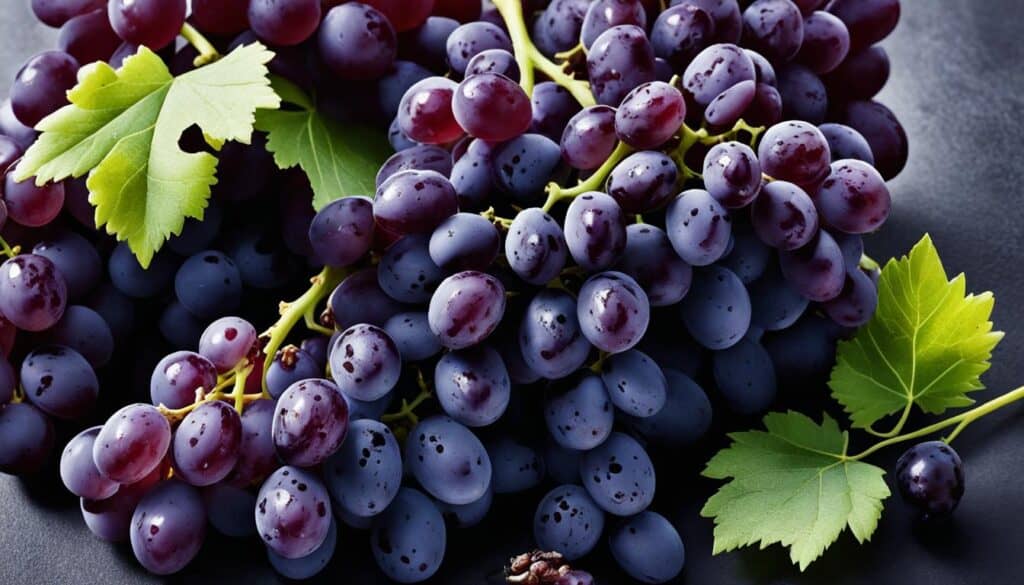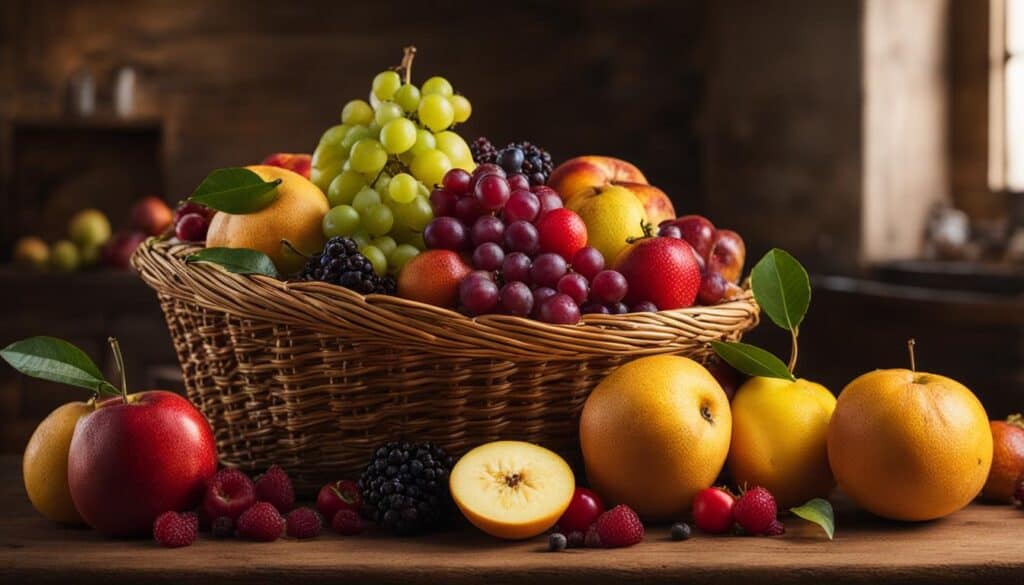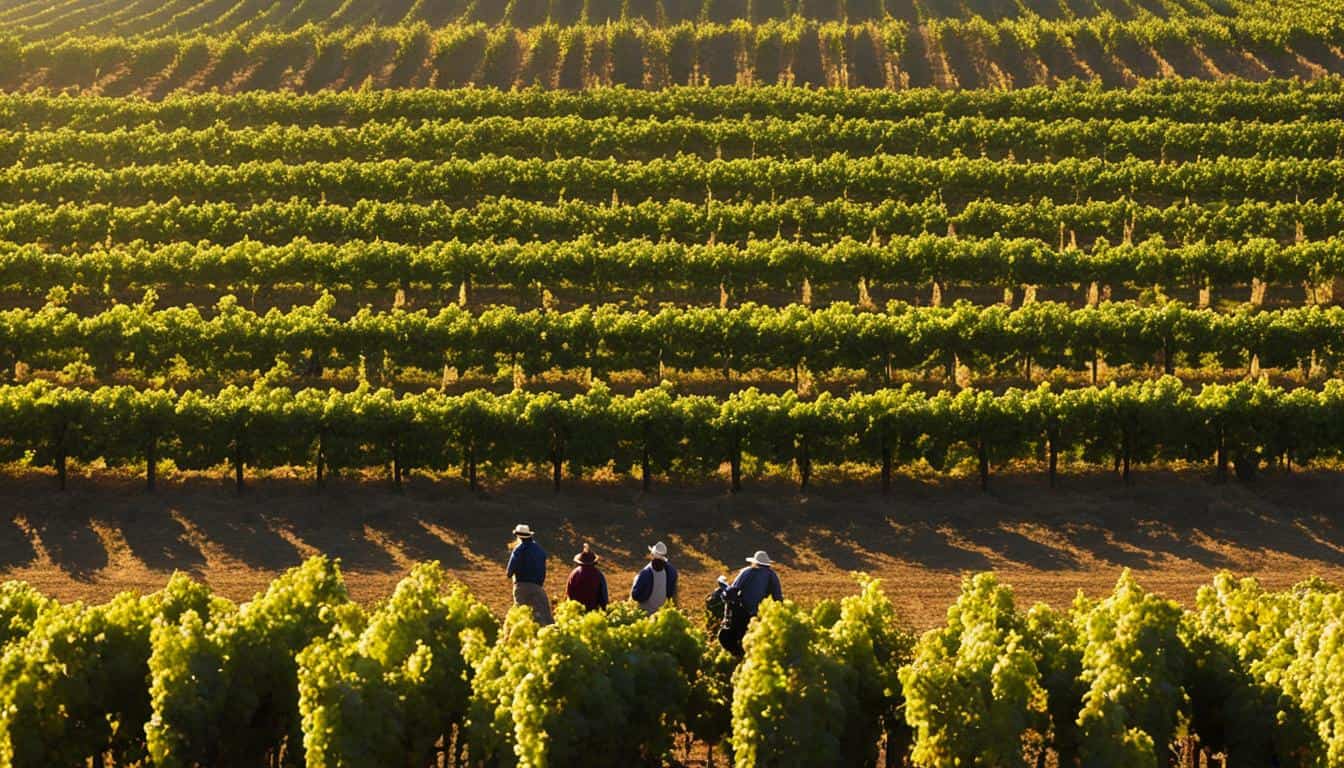Have you ever wondered what fruit raisins come from? Raisins are a delicious and versatile treat that have been enjoyed for centuries. They are actually dried grapes, and they come from different varieties of grapes. The word “raisin” is a loanword from Old French, derived from the Latin word “racemus,” meaning “a bunch of grapes.”
Raisins are produced in various regions of the world and are enjoyed both raw and in cooking, baking, and brewing. In the United Kingdom, Ireland, New Zealand, Australia, and South Africa, the term “raisin” specifically refers to the dark-colored dried large grape. The golden-colored dried grape is called a sultana, and a dried small Black Corinth seedless grape is known as a currant.
Key Takeaways:
- Raisins are dried grapes and come from different varieties of grapes.
- The word “raisin” is derived from the Latin word “racemus,” meaning “a bunch of grapes.”
- Raisins are produced in various regions of the world and are enjoyed in various culinary applications.
- The term “raisin” refers to different dried grapes, such as dark-colored large grapes, golden sultanas, and small Black Corinth seedless grapes known as currants.
- The journey of what fruit raisins come from adds an extra layer of flavor and history to this beloved treat.
Varieties of Raisins
Raisins come in a variety of sizes, colors, and flavors depending on the type of grape used. Let’s explore some of the most common raisin varieties:
Sultana Raisin
The sultana raisin, also known as Thompson Seedless in the United States, is one of the most popular raisins. It is made from green grapes and has a golden color and a sweet taste.
Zante Currants
Zante currants, also known as black Corinthian raisins, are made from small seedless grapes. They are dark in color and have a tangy flavor.
Flame Grapes
Flame grapes are used to make flame raisins, which are larger and have a dark red color. They have a sweet and juicy flavor.
Sun-Dried Raisins
Traditionally, raisins are sun-dried, which means they are naturally dried under the sun. This method gives raisins a chewy texture and enhances their natural sweetness.
Artificially Dehydrated Raisins
In addition to sun-drying, raisins can also be artificially dehydrated using controlled temperature and humidity. This method results in raisins with a lighter color and higher moisture content.
Golden Raisins
Golden raisins are dried in dehydrators with controlled temperature and humidity. They have a light color and a sweeter flavor compared to other raisin varieties.
Black Corinth or Zante Currant
The Black Corinth or Zante currant is a small, dark raisin with a tangy flavor. It is often used in baking and cooking.
Muscat Raisins
Muscat raisins are larger and sweeter compared to other raisin varieties. They have a distinctive flavor and are often enjoyed as a snack or used in desserts.
Here is a table summarizing the different types of raisins:
| Raisin Variety | Description |
|---|---|
| Sultana Raisin (Thompson Seedless) | Made from green grapes, golden color, sweet taste |
| Zante Currants (Black Corinthian) | Made from small seedless grapes, dark color, tangy flavor |
| Flame Grapes | Larger size, dark red color, sweet and juicy flavor |
| Sun-Dried Raisins | Naturally dried under the sun, chewy texture, enhanced sweetness |
| Artificially Dehydrated Raisins | Dried using controlled temperature and humidity, lighter color, higher moisture content |
| Golden Raisins | Light color, sweeter flavor, dried with controlled temperature and humidity |
| Black Corinth or Zante Currant | Small and dark, tangy flavor, commonly used in baking and cooking |
| Muscat Raisins | Larger size, sweeter flavor, often enjoyed as a snack or used in desserts |
Now that we’ve explored the different varieties of raisins, it’s clear that there is a raisin to suit every taste and culinary need. Whether you prefer the sweetness of sultanas, the tanginess of Zante currants, or the unique flavor of Muscat raisins, there’s no shortage of options to choose from. Enjoy these delicious dried grapes in your favorite recipes or as a wholesome snack!
Raisin Production Process
Commercial raisin production involves several essential steps to transform fresh grapes into delicious dried raisins. Let’s take a closer look at the intricate process behind raisin production.
Grape Drying
Once the grapes are harvested, the drying process begins. Drying is critical as it removes the majority of the grape’s water content, resulting in the shriveled raisins we all know and love. The drying methods for grapes can vary, but they typically include sun drying, shade drying, and mechanical drying. Mechanical drying is the preferred method due to its controlled environment and higher safety standards.
Pre-treatment
Before the grapes are dried, pre-treatment is necessary to facilitate the water removal during the drying process. Historically, dry emulsion cold dips made of potassium carbonate and ethyl esters of fatty acids were utilized for pre-treatment. However, recent advancements have introduced new techniques involving oil emulsions or dilute alkaline solutions. These methods aid in enhancing the rate of water removal, ensuring optimal raisin production.
Post-drying Processes
Once the grapes have undergone the drying process, post-drying processes are implemented to prepare the raisins for consumption. These processes involve meticulous cleaning to remove any foreign objects, stems, or off-grade raisins. Cleanliness is crucial in ensuring the highest quality raisins reach the market.
Sulfur Dioxide in Raisins
To prevent browning and preserve flavor, raisins may undergo a treatment involving the application of sulfur dioxide. Sulfur dioxide acts as an antioxidant and helps maintain the freshness of raisins. It also aids in preserving certain vitamins present in the raisins. It’s important to note that sulfur dioxide usage in raisins is regulated and monitored to ensure consumer safety.
California Raisin Production
California has established itself as a prominent producer of raisins, accounting for a significant portion of global raisin production. The state’s favorable climate and extensive vineyards make it an ideal region for cultivating grapes. California’s commitment to quality and expertise in raisin production has earned it a reputation as one of the leading sources of delicious raisins.
Understanding the meticulous steps involved in raisin production allows us to appreciate the effort and expertise required to bring these delectable dried fruits to our tables.
Raisin Nutrition

Raisins are not only delicious but also packed with essential nutrients that contribute to a healthy diet. Let’s take a closer look at the nutrition profile of raisins.
• Calories in Raisins: In a 100-gram serving of raisins, you’ll find approximately 299 kilocalories of energy.
• Carbohydrates in Raisins: Raisins are composed of approximately 79% carbohydrates. These carbohydrates provide a steady release of energy to keep you fueled throughout the day.
• Sugars in Raisins: The natural sweetness of raisins comes from their sugar content. While 100 grams of raisins contain around 59 grams of sugars, they are naturally occurring sugars found in grapes.
• Fiber in Raisins: Raisins are an excellent source of dietary fiber, with approximately 4 grams of fiber per 100 grams. Fiber is important for maintaining a healthy digestive system and promoting feelings of fullness.
• Vitamins in Raisins: Raisins contain a range of vitamins, including thiamine, riboflavin, and vitamin B6. These vitamins play essential roles in energy metabolism, maintaining healthy skin, and supporting brain function.
• Minerals in Raisins: Raisins also provide a moderate amount of minerals such as calcium, iron, and potassium. These minerals are necessary for various bodily functions, including bone health, oxygen transport, and proper nerve function.
Notably, raisins are a good source of antioxidants, which help protect your body against damage from harmful free radicals.
The Benefits of Including Raisins in Your Diet
By incorporating raisins into your regular meal plans, you can enjoy the following benefits:
- Steady Energy Release: The carbohydrates and natural sugars in raisins provide a sustained release of energy, helping to keep you fueled throughout the day.
- Healthy Digestion: The fiber content aids in maintaining a healthy digestive system, supporting regular bowel movements.
- Heart Health: Raisins may contribute to heart health by helping to lower cholesterol levels and reducing the risk of cardiovascular diseases.
- Nutrient Boost: The vitamins and minerals in raisins add essential nutrients to your diet, promoting overall health and well-being.
Incorporating raisins into a balanced diet can be an enjoyable way to enhance your nutrition and support a healthy lifestyle.
Raisin Production Worldwide
Raisin production is a global industry, with several countries leading in production. In 2020–2021, the top raisin-producing countries were Turkey, the United States, Iran, and India. Turkey, the largest producer of raisins, benefits from its favorable climate and conditions for grape cultivation, allowing for high-quality raisin production. The United States also holds a significant position in raisin production, contributing to the global supply. Iran and India, with their suitable climates, are also major players in the industry.
Other countries, such as Greece, Chile, and South Africa, also make notable contributions to global raisin production. These countries leverage their unique geographical advantages to cultivate grapes and produce raisins that meet the demand of consumers worldwide. The global nature of raisin production ensures a diverse range of flavors, colors, and qualities from different regions.

History of Raisins and Dried Fruit
Raisins have a fascinating and ancient history. They have been enjoyed by various civilizations throughout time, including the Phoenicians, Egyptians, Greeks, and Romans. These dried fruits were highly valued for their long-term storability and were even used as rewards, prizes, and trade goods.
The popularity of raisins can be traced back to ancient cultures, where they were used in various dishes and desserts. The Phoenicians and Egyptians, in particular, had a significant influence on the spread and popularity of raisins. They recognized the value of dried fruits and incorporated them into their culinary traditions.
During the Crusades and the Age of Exploration, raisins played a critical role in trade between Europe and other parts of the world. European explorers discovered the delicious and nutritious qualities of raisins and began importing them from distant lands. This trade not only introduced raisins to European cuisine but also contributed to the development of global trade networks.
Raisins became an essential ingredient in European cuisine, with recipes incorporating dried fruits in a variety of savory and sweet dishes. From cakes and bread to stews and tagines, raisins added a burst of flavor and texture to traditional European recipes.

The Age of Exploration and trade routes allowed for the exchange of raisins and other dried fruits across continents. As European explorers ventured into new territories, they brought back not only spices and precious goods but also dried fruits like raisins. The trade of raisins during this period played a significant role in shaping culinary traditions worldwide.
In summary, the history of raisins is deeply intertwined with human civilization. From their ancient popularity to their presence in European cuisine and trade during the Age of Exploration, raisins have left an indelible mark on our culinary and cultural heritage.
Raisins in Literature and Culture
Raisins have played a prominent role in both literature and culture throughout history. Their presence can be found in ancient texts, classic poems, beloved novels, and even in popular children’s stories. The humble raisin has managed to find its way into numerous works of literature, captivating readers with its unique qualities and symbolism.
”A raisin in the sun.” – Lorraine Hansberry
”I wish those raisins had faces so we could spit on them.” – J.D. Salinger
In addition to their literary significance, raisins have been an essential ingredient in cooking traditions that have been passed down through generations. From hearty stews to sweet baked goods, raisins lend their distinct flavor and texture in dishes across cultures.
One particularly popular recipe featuring raisins is the classic Irish soda bread. The raisins add bursts of sweetness to the bread, creating a delightful contrast with its dense texture. Another beloved dish is rice pudding, where raisins are soaked in warm milk, plumping up and infusing the dessert with their natural sweetness.
Furthermore, raisins have made their way into popular culture in various forms. Whether as a snack enjoyed by kids and adults alike or as an ingredient in favorite recipes, raisins remain a staple in many households. In fact, raisins are a common addition to oatmeal cookies, granola bars, and trail mixes.
- Raisins in trail mixes
- Raisins in granola bars
- Raisins in oatmeal cookies
The versatile nature of raisins has ensured their enduring presence in both literature and culture. With their unique flavor and texture, raisins continue to captivate our palates and add a touch of sweetness to our lives.
Oh, the places raisins have been!
| Raisins in Literature | Raisins in Cooking Traditions | Raisins in Popular Culture |
|---|---|---|
| “A raisin in the sun” – Lorraine Hansberry | Irish soda bread | Raisins in trail mixes |
| “I wish those raisins had faces so we could spit on them” – J.D. Salinger | Rice pudding | Raisins in granola bars |
| Oatmeal cookies |
Raisins in Exploration and Space
Raisins have played an important role in the world of exploration and space missions. Throughout history, these dried grapes have accompanied adventurers and explorers, providing a source of sustenance during their challenging expeditions.
Raisins in Expeditions
During expeditions to both the North and South Poles, raisins have served as a reliable source of sustenance for explorers. Notable explorers like Robert E. Peary, who conquered the North Pole, and Robert Falcon Scott, who led expeditions to the South Pole, relied on raisins to fuel and nourish their bodies during their arduous journeys.
Raisins as Sustenance
The compact size and high nutritional value of raisins make them an ideal choice for expeditions where weight and portability are crucial. Packed with carbohydrates, vitamins, and minerals, raisins provide a quick and convenient source of energy for explorers on the go. Their long shelf life and resistance to spoilage also make them a reliable food source in remote and challenging environments.
Raisins in Space Missions
The role of raisins extends beyond earthly expeditions. In 1962, astronaut Scott Carpenter became the first person to carry and consume raisins in outer space. Raisins provide a concentrated burst of energy and nutrients, making them a practical choice for space missions where astronauts require compact and nutritious food options.
“Raisins have been a staple in expeditions, providing explorers with the sustenance they need to fuel their journeys. From the rugged terrains of the polar regions to the vastness of outer space, raisins have proven their reliability as a source of energy and nourishment.”
Table: Nutritional Content of Raisins
| Nutrient | Amount per 100g |
|---|---|
| Energy | 299 kcal |
| Carbohydrates | 79g |
| Fiber | 4g |
| Protein | 3g |
| Calcium | 50mg |
| Iron | 1.9mg |
| Potassium | 749mg |
| Thiamine (Vitamin B1) | 0.1mg |
| Riboflavin (Vitamin B2) | 0.2mg |
| Vitamin B6 | 0.1mg |
As shown in the table above, raisins are packed with essential nutrients, making them a valuable food source for explorers and astronauts alike.
Raisin Recipes and Traditions
Raisins are not only a delicious snack on their own but also a versatile ingredient in various recipes and culinary traditions. From breads to puddings and cakes to desserts, raisins add a natural sweetness and depth of flavor to these dishes, making them a favorite among home cooks and professional chefs alike.
Traditional Raisin Dishes
One of the most popular traditional raisin dishes is plum pudding. This rich, steamed dessert is typically made with raisins, along with suet, breadcrumbs, flour, sugar, and a blend of warm spices. The raisins plump up during the cooking process, creating pockets of sweetness throughout the pudding.
Another classic dish that features raisins is stollen, a German fruit bread. Stollen is enriched with butter, sugar, and spices and studded with raisins. It is often enjoyed during the Christmas season, either plain or with a generous dusting of powdered sugar.
For those with a penchant for Italian cuisine, panettone is a must-try raisin-filled treat. This sweet bread is typically enjoyed around the holidays and features raisins, candied citrus peel, and sometimes even chocolate. It has a light and fluffy texture, perfect for slicing and enjoying with a cup of coffee or tea.
Raisin Bread
Raisin bread is a classic breakfast or snack option loved by many. The plump and juicy raisins are mixed into the bread dough, creating pockets of sweetness throughout each slice. Whether toasted and spread with butter or enjoyed as is, raisin bread adds a touch of sweetness to your morning routine.
Raisin Pudding
Raisin pudding is a comforting and indulgent dessert that satisfies both the sweet tooth and the soul. This warm and creamy treat is often made with ingredients like eggs, milk, sugar, and of course, raisins. It can be baked or steamed to perfection, resulting in a moist and flavorful pudding that pairs well with a dollop of whipped cream or a drizzle of caramel sauce.
Raisin Cake
Raisin cake is a classic dessert that transcends generations. From traditional fruitcakes to spiced carrot cakes, raisins add an extra level of flavor and texture to these moist and delectable treats. The sweetness of the raisins complements the other ingredients, creating a harmonious blend of flavors that will keep you coming back for more.
Raisin Desserts
Raisins can be found in a wide variety of dessert recipes, from cookies and bars to pies and tarts. They can add a burst of sweetness and chewy texture to your favorite sweet treats. Whether you’re craving an oatmeal raisin cookie, a sticky date and raisin cake, or a classic raisin pie, there are endless possibilities when it comes to incorporating raisins into your desserts.
Whether you’re following cherished family recipes or experimenting with new creations, raisins are a versatile ingredient that can elevate your dishes and bring joy to every bite.

Health Benefits of Raisins
Raisins offer a wide range of health benefits that make them a valuable addition to any diet. These tiny dried fruits are not only delicious but also packed with nutrients that can positively impact your overall well-being.
One of the key health benefits of raisins is their high antioxidant content. Antioxidants play a crucial role in protecting the body against damage caused by harmful molecules known as free radicals. The antioxidants in raisins help neutralize these free radicals, reducing the risk of chronic diseases and promoting cellular health.
Raisins are also beneficial for heart health. They contain natural compounds that can lower blood pressure and improve overall cardiovascular function. Regular consumption of raisins may help reduce the risk of heart disease and stroke.
In addition to their cardiovascular benefits, raisins can support digestion. The high fiber content in raisins promotes regular bowel movements and aids in maintaining a healthy digestive system. Adding raisins to your diet can help prevent constipation and promote a healthy gut.
Furthermore, raisins contribute to bone health due to their mineral content, including calcium and boron. These minerals are essential for maintaining strong and healthy bones. Including raisins in your diet can help protect against osteoporosis and support overall bone density.
Raisins are a natural snack choice that provides a burst of energy and satisfies sweet cravings in a healthier way. Their natural sugars provide a quick energy boost, making them an excellent option for a pre-workout snack or a mid-afternoon pick-me-up.
To summarize, here are some of the health benefits of raisins:
- Rich in antioxidants, which protect against cellular damage
- Promote heart health and lower blood pressure
- Aid digestion and support a healthy gut
- Contribute to strong and healthy bones
- Provide a natural energy boost in a healthier snack option
By incorporating raisins into a balanced diet, you can enjoy their delicious flavor while reaping the numerous health benefits they offer.
| Nutrient | Amount per 100g |
|---|---|
| Calories | 299 kcal |
| Carbohydrates | 79g |
| Sugars | 59g |
| Fiber | 4g |
| Calcium | 50mg |
| Iron | 1.8mg |
| Potassium | 749mg |
Considerations for Raisin Consumption
While enjoying raisins can provide numerous health benefits, it’s important to be aware of certain considerations. These include the potential toxicity of raisins in animals and the risks associated with consuming raisins for individuals with specific medical conditions.
Raisins, when ingested by certain pets, particularly dogs and cats, can be harmful and even cause kidney failure. Therefore, it’s crucial to keep raisins out of reach of animals and refrain from feeding them to pets. This ensures the safety and well-being of our furry companions.
Furthermore, individuals with medical conditions such as diabetes or allergies should consume raisins in moderation and consult with a healthcare professional if necessary. It’s important to consider how raisins may affect blood sugar levels and any potential allergenic reactions.
By being mindful of these considerations, we can safely and responsibly enjoy the many benefits that raisins have to offer.
Conclusion
As we conclude our exploration of raisins, it’s clear that these dried grapes have a fascinating history and are deeply rooted in culinary traditions worldwide. From their humble origins as dried grapes, raisins have evolved into a beloved and versatile food that can be enjoyed in various forms. Whether you prefer to snack on a handful of raisins or incorporate them into your favorite recipes, their journey from fruit to raisin adds an extra layer of flavor and history to this cherished treat.
Raisin production continues to thrive globally, with different countries contributing to the industry. From the largest producers like Turkey and the United States to Iran and India, the art of drying grapes to create raisins has become a vital part of their agricultural economies. The popularity and demand for raisins have only grown over the years, emphasizing their enduring appeal and widespread consumption.
As you savor the rich flavors and chewy texture of raisins, take a moment to appreciate the centuries of history and tradition that have gone into their production. Whether you’re adding them to your morning oatmeal, baking them into a delectable dessert, or simply enjoying them as a guilt-free snack, raisins are a delightful reminder of the fruits’ journey and the cultural significance they hold. So the next time you reach for a handful of raisins, remember the remarkable story behind this versatile and timeless treat.
FAQ
What fruit do raisins come from?
Raisins are dried grapes, which means they come from different varieties of grapes.
What are the types of fruits that become raisins?
Some common raisin varieties include the sultana, Zante currants (black Corinthian raisins), and Flame grapes.
What is the origin of raisins as a fruit?
The word “raisin” is a loanword from Old French, derived from the Latin word “racemus,” meaning “a bunch of grapes.”
Where do raisins come from?
Raisins are produced in various regions of the world, with Turkey, the United States, Iran, and India being the top raisin-producing countries.
How are raisins made from fruits?
Raisins are traditionally sun-dried, but they can also be artificially dehydrated using controlled temperature and humidity.
What is the fruit used for making raisins?
Different varieties of grapes, such as Thompson Seedless grapes, are used for making raisins.
What is the raisin production process?
The raisin production process involves pre-treatment, grape drying using methods like sun drying, shade drying, or mechanical drying, and post-drying processes like cleaning and sulfur dioxide treatment.
Where are raisins commercially produced?
California is a significant producer of raisins.
What are the nutritional values of raisins?
Raisins are approximately 15% water, 79% carbohydrates, 4% fiber, and contain moderate amounts of dietary minerals and vitamins.
Which countries lead in raisin production?
Turkey is the largest producer of raisins, followed by the United States, Iran, and India.
What is the history of raisins as a fruit?
Raisins have been enjoyed since ancient times and were popular among civilizations such as the Phoenicians, Egyptians, Greeks, and Romans. They played a significant role in trade during the Crusades and the Age of Exploration.
How have raisins been featured in literature and culture?
Raisins have been mentioned in ancient texts, poems, and novels. They have been an essential ingredient in traditional cooking and baking and continue to be referenced in modern culture.
What role have raisins played in exploration and space missions?
Raisins have been used as a source of sustenance by explorers and have even been consumed in space missions.
What are some popular raisin recipes and culinary traditions?
Raisins are a popular ingredient in bread, pudding, cakes, cookies, and other desserts. Traditional dishes like plum pudding, stollen, and panettone often feature raisins.
What are the health benefits of eating raisins?
Raisins are a good source of antioxidants, can contribute to heart health, digestion, and bone health, and can be part of a balanced diet.
Are there any considerations for consuming raisins?
While raisins are generally safe for human consumption, they can be harmful to pets, particularly dogs and cats. Individuals with certain medical conditions should consume raisins in moderation and seek advice from a healthcare professional.





Leave a Reply